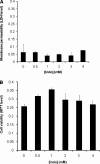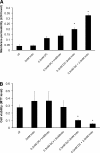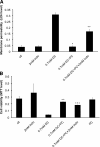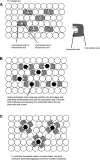Effect of indomethacin on bile acid-phospholipid interactions: implication for small intestinal injury induced by nonsteroidal anti-inflammatory drugs
- PMID: 20203063
- PMCID: PMC2867422
- DOI: 10.1152/ajpgi.00387.2009
Effect of indomethacin on bile acid-phospholipid interactions: implication for small intestinal injury induced by nonsteroidal anti-inflammatory drugs
Abstract
The injurious effect of nonsteroidal anti-inflammatory drugs (NSAIDs) in the small intestine was not appreciated until the widespread use of capsule endoscopy. Animal studies found that NSAID-induced small intestinal injury depends on the ability of these drugs to be secreted into the bile. Because the individual toxicity of amphiphilic bile acids and NSAIDs directly correlates with their interactions with phospholipid membranes, we propose that the presence of both NSAIDs and bile acids alters their individual physicochemical properties and enhances the disruptive effect on cell membranes and overall cytotoxicity. We utilized in vitro gastric AGS and intestinal IEC-6 cells and found that combinations of bile acid, deoxycholic acid (DC), taurodeoxycholic acid, glycodeoxycholic acid, and the NSAID indomethacin (Indo) significantly increased cell plasma membrane permeability and became more cytotoxic than these agents alone. We confirmed this finding by measuring liposome permeability and intramembrane packing in synthetic model membranes exposed to DC, Indo, or combinations of both agents. By measuring physicochemical parameters, such as fluorescence resonance energy transfer and membrane surface charge, we found that Indo associated with phosphatidylcholine and promoted the molecular aggregation of DC and potential formation of larger and isolated bile acid complexes within either biomembranes or bile acid-lipid mixed micelles, which leads to membrane disruption. In this study, we demonstrated increased cytotoxicity of combinations of bile acid and NSAID and provided a molecular mechanism for the observed toxicity. This mechanism potentially contributes to the NSAID-induced injury in the small bowel.
Figures









Similar articles
-
Indomethacin disrupts the protective effect of phosphatidylcholine against bile salt-induced ileal mucosa injury.Eur J Clin Invest. 2006 Feb;36(2):105-12. doi: 10.1111/j.1365-2362.2006.01595.x. Eur J Clin Invest. 2006. PMID: 16436092
-
Indomethacin enhances bile salt detergent activity: relevance for NSAIDs-induced gastrointestinal mucosal injury.Dig Dis Sci. 2006 Apr;51(4):766-74. doi: 10.1007/s10620-006-3204-1. Dig Dis Sci. 2006. PMID: 16615001
-
In vitro and in vivo protection against indomethacin-induced small intestinal injury by proton pump inhibitors, acid pump antagonists, or indomethacin-phosphatidylcholine.Digestion. 2012;86(2):171-7. doi: 10.1159/000339882. Epub 2012 Aug 14. Digestion. 2012. PMID: 22907267 Free PMC article.
-
Intestinal mucosal damage caused by non-steroidal anti-inflammatory drugs: role of bile salts.Clin Biochem. 2007 May;40(8):503-10. doi: 10.1016/j.clinbiochem.2007.01.015. Epub 2007 Jan 31. Clin Biochem. 2007. PMID: 17321514 Review.
-
[Mechanism of Taurohyodeoxycholate-induced Biliary Phospholipid Efflux -Understanding the Function of the ABCB4 Enhancer for Developing Therapeutic Agents against Bile Salt-induced Liver Injury].Yakugaku Zasshi. 2020;140(11):1329-1334. doi: 10.1248/yakushi.20-00156. Yakugaku Zasshi. 2020. PMID: 33132268 Review. Japanese.
Cited by
-
Indomethacin-induced translocation of bacteria across enteric epithelia is reactive oxygen species-dependent and reduced by vitamin C.Am J Physiol Gastrointest Liver Physiol. 2012 Sep 1;303(5):G536-45. doi: 10.1152/ajpgi.00125.2012. Epub 2012 Jun 14. Am J Physiol Gastrointest Liver Physiol. 2012. PMID: 22700821 Free PMC article.
-
Current knowledge on non-steroidal anti-inflammatory drug-induced small-bowel damage: a comprehensive review.J Gastroenterol. 2020 May;55(5):481-495. doi: 10.1007/s00535-019-01657-8. Epub 2019 Dec 21. J Gastroenterol. 2020. PMID: 31865463 Free PMC article. Review.
-
Indomethacin injury to the rat small intestine is dependent upon biliary secretion and is associated with overgrowth of enterococci.Physiol Rep. 2016 Mar;4(6):e12725. doi: 10.14814/phy2.12725. Epub 2016 Mar 31. Physiol Rep. 2016. PMID: 27033447 Free PMC article.
-
Lipid based therapy for ulcerative colitis-modulation of intestinal mucus membrane phospholipids as a tool to influence inflammation.Int J Mol Sci. 2010 Oct 25;11(10):4149-64. doi: 10.3390/ijms11104149. Int J Mol Sci. 2010. PMID: 21152327 Free PMC article. Review.
-
Bile acids modulate signaling by functional perturbation of plasma membrane domains.J Biol Chem. 2013 Dec 13;288(50):35660-70. doi: 10.1074/jbc.M113.519116. Epub 2013 Oct 28. J Biol Chem. 2013. PMID: 24165125 Free PMC article.
References
-
- Bjarnason I, Hayllar J, MacPherson AJ, Russell AS. Side effects of nonsteroidal anti-inflammatory drugs on the small and large intestine in humans. Gastroenterology 104: 1832–1847, 1993 - PubMed
-
- Brune K, Nurnberg B, Szelenyi I. The Enterohepatic Circulation of Some Anti-Inflammatory Drugs May Cause Intestinal Ulcerations Boston, MA: MTP Press, 1985
-
- Carey MC, Montet JC, Phillips MC, Armstrong MJ, Mazer NA. Thermodynamic and molecular basis for dissimilar cholesterol-solubilizing capacities by micellar solutions of bile salts: cases of sodium chenodeoxycholate and sodium ursodeoxycholate and their glycine and taurine conjugates. Biochemistry 20: 3637–3648, 1981 - PubMed
-
- Carey MC, Small DM. Micellar properties of dihydroxy and trihydroxy bile salts: effects of counterion and temperature. J Colloid Interface Sci 31: 382–396, 1969 - PubMed
-
- Clarke RJ. Effect of lipid structure on the dipole potential of phosphatidylcholine bilayers. Biochim Biophys Acta 1327: 269–278, 1997 - PubMed
Publication types
MeSH terms
Substances
Grants and funding
LinkOut - more resources
Full Text Sources
Research Materials

